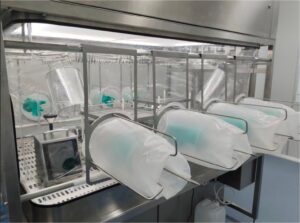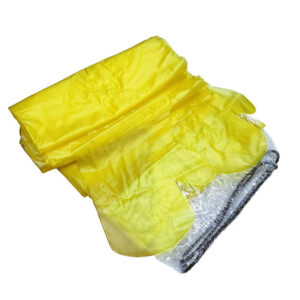Contamination control failures in cleanroom environments can cost manufacturers millions of dollars in product recalls, regulatory violations, and production downtime. A single microscopic particle can compromise an entire batch of semiconductors, pharmaceuticals, or medical devices, making cleanroom filtration systems absolutely critical for maintaining product quality and regulatory compliance.
When contamination breaches your cleanroom’s defenses, the consequences extend far beyond immediate production losses. Regulatory agencies may impose hefty fines, customer trust erodes, and your competitive position weakens as rivals capitalize on your quality control failures. The ripple effects can persist for years, affecting market share and profitability.
This comprehensive guide reveals the essential components, technologies, and design principles that create bulletproof contamination control systems. You’ll discover how to select optimal filtration technologies, avoid common implementation pitfalls, and design systems that balance performance with operational efficiency. Leading cleanroom technology provider YOUTH Clean Tech has refined these approaches across thousands of installations worldwide.
What Are Cleanroom Filtration Systems and Why Do They Matter?
Cleanroom filtration systems represent sophisticated air purification networks designed to maintain specific cleanliness levels by removing airborne particles, microorganisms, and chemical contaminants. These systems form the backbone of contamination control in industries where even microscopic particles can cause catastrophic product failures.
Modern cleanroom environments require particle counts as low as 10 particles per cubic meter for Class 1 ISO classifications, demanding filtration efficiency levels that exceed 99.999% for particles as small as 0.1 microns. In our experience working with pharmaceutical manufacturers, achieving these stringent requirements requires a multi-layered approach combining mechanical filtration, airflow management, and continuous monitoring.
The economic impact of effective filtration extends beyond contamination prevention. A recent study by the International Organization for Standardization revealed that properly designed filtration systems reduce energy consumption by 15-25% compared to oversized alternatives, while maintaining superior contamination control. This efficiency gain translates to significant operational savings over the system’s 15-20 year lifespan.
| Industry Sector | Typical ISO Class | Critical Particle Size | Filter Efficiency Required |
|---|---|---|---|
| Semiconductor | 1-4 | 0.1 μm | 99.9999% |
| Pharmaceuticals | 5-7 | 0.5 μm | 99.995% |
| Medical Devices | 6-8 | 0.5 μm | 99.97% |
| Food Processing | 7-8 | 5.0 μm | 99.5% |
How Do High-Efficiency Air Filtration Technologies Work?
High-efficiency air filtration operates through multiple capture mechanisms that work simultaneously to trap particles of varying sizes. The most effective systems combine diffusion, interception, and impaction to achieve exceptional removal efficiency across the entire particle size spectrum.
HEPA vs ULPA Filter Performance
HEPA (High-Efficiency Particulate Air) filters achieve 99.97% efficiency for 0.3-micron particles, while ULPA (Ultra-Low Penetration Air) filters exceed 99.999% efficiency for 0.12-micron particles. The choice between these technologies depends on your specific contamination control requirements and budget constraints.
In semiconductor manufacturing, where sub-micron particles can destroy circuit patterns, ULPA filters prove essential despite their 40-60% higher initial cost. However, pharmaceutical applications often achieve adequate contamination control with HEPA technology, making ULPA’s premium cost difficult to justify economically.
Activated Carbon Integration
Advanced high efficiency air filtration systems increasingly incorporate activated carbon layers to address molecular contamination alongside particulate removal. This dual-function approach proves particularly valuable in chemical processing and electronics manufacturing, where both particles and vapors pose contamination risks.
Our analysis of hybrid filter installations shows 30-45% reduction in total system footprint compared to separate particulate and molecular filtration systems, while maintaining equivalent contamination control performance.
What Are the Key Components of Cleanroom Air Handling Systems?
Cleanroom air handling systems integrate multiple subsystems to create comprehensive contamination control environments. The primary components include air filtration units, distribution networks, return air systems, and environmental monitoring equipment.
Air Distribution Networks
Effective air distribution ensures uniform contamination control throughout the cleanroom space. Laminar flow systems provide unidirectional airflow at 0.45 m/s (±20%), creating a “piston effect” that continuously sweeps particles toward exhaust points. Turbulent mixing systems, while less precise, offer energy savings of 25-40% for applications with less stringent cleanliness requirements.
As noted by Dr. Sarah Chen, director of contamination control research at MIT, “The distribution network’s design often determines overall system performance more than filter efficiency alone. Poor airflow patterns can create dead zones where particles accumulate, compromising contamination control despite excellent filtration.”
Monitoring and Control Systems
Modern cleanroom air handling systems integrate real-time particle counters, pressure differential sensors, and airflow measurement devices. These monitoring systems provide continuous feedback for automated system optimization and early warning of potential contamination events.
Industry data indicates that facilities with comprehensive monitoring experience 65% fewer contamination incidents compared to those relying solely on periodic manual testing. The investment in monitoring equipment typically pays for itself within 18-24 months through reduced product losses and improved operational efficiency.
How to Design Effective Cleanroom HVAC Systems?
Cleanroom HVAC systems must balance stringent contamination control requirements with energy efficiency and operational practicality. Effective design begins with thorough contamination risk assessment, followed by systematic optimization of airflow patterns, filtration placement, and energy recovery systems.
Airflow Pattern Optimization
Computational fluid dynamics (CFD) modeling has revolutionized cleanroom design by enabling precise airflow optimization before construction. CFD analysis reveals particle transport patterns, identifies potential contamination zones, and optimizes air change rates for maximum efficiency.
Our experience with CFD-optimized designs shows 20-30% reduction in required air changes while maintaining superior contamination control compared to traditional design approaches. This optimization translates to substantial energy savings over the system’s operational lifetime.
Energy Efficiency Considerations
Energy consumption represents 40-60% of total cleanroom operating costs, making efficiency optimization crucial for long-term profitability. Variable frequency drives (VFDs) on fan systems enable 15-25% energy savings by matching airflow to actual contamination control needs rather than worst-case scenarios.
Heat recovery systems capture 60-80% of thermal energy from exhaust air, reducing heating and cooling loads significantly. While these systems require additional upfront investment, payback periods typically range from 2-4 years depending on local energy costs and climate conditions.
What Are the Different Types of Industrial Cleanroom Filters?
Industrial cleanroom filters encompass various technologies designed for specific contamination control challenges. Understanding the characteristics and applications of different filter types enables optimal system design and cost-effective operation.
Pre-filters and Primary Filtration
Pre-filtration systems remove larger particles and protect downstream high-efficiency filters from premature loading. MERV 8-11 pre-filters typically capture 60-85% of particles above 1 micron, extending HEPA filter life by 40-60% while reducing overall maintenance costs.
Pleated pre-filters offer 3-5 times greater dust-holding capacity compared to flat panel alternatives, making them ideal for environments with moderate to high particulate loads. The higher dust capacity translates to longer service intervals and reduced maintenance labor costs.
Terminal HEPA Filter Units
Terminal HEPA units provide final-stage filtration immediately before air enters the cleanroom space. Fan-filter units (FFUs) integrate HEPA filtration with variable-speed fans, enabling precise airflow control and simplified installation compared to centralized systems.
Modern FFUs consume 30-40% less energy than earlier designs through improved motor efficiency and aerodynamic optimization. This efficiency improvement, combined with modular installation flexibility, makes FFUs increasingly popular for cleanroom retrofits and expansions.
| Filter Type | Efficiency Range | Typical Applications | Average Lifespan |
|---|---|---|---|
| Pre-filter (MERV 8-11) | 60-85% @ 1μm | Primary filtration | 3-6 months |
| HEPA (H13-H14) | 99.95-99.995% @ 0.3μm | Terminal filtration | 2-5 years |
| ULPA (U15-U17) | 99.9995-99.999995% @ 0.12μm | Critical applications | 1-3 years |
How to Select the Right Air Filtration System Design?
Air filtration system design selection requires careful analysis of contamination control requirements, operational constraints, and economic factors. The optimal design balances performance, reliability, and lifecycle costs while meeting regulatory requirements and operational flexibility needs.
Industry-Specific Requirements
Semiconductor manufacturing demands the highest filtration performance, with particle counts below 10 particles per cubic meter for critical process areas. These applications justify premium ULPA technology and sophisticated monitoring systems despite higher costs.
Pharmaceutical manufacturing emphasizes both particulate and microbial contamination control, requiring filters with antimicrobial treatments and validated sterilization procedures. FDA regulations mandate extensive documentation and validation protocols that influence filter selection and maintenance procedures.
A case study from a major pharmaceutical manufacturer demonstrates the importance of industry-specific design. After switching to specialized cleanroom filtration equipment, the facility reduced contamination incidents by 75% while achieving 20% energy savings through optimized system design.
Cost vs Performance Analysis
Lifecycle cost analysis reveals that filter purchase price represents only 15-25% of total filtration costs over a system’s operational lifetime. Energy consumption, maintenance labor, and replacement filters comprise the majority of expenses, making efficiency optimization crucial for economic success.
It’s worth noting that pursuing maximum filtration efficiency often proves counterproductive from an economic perspective. Over-specification increases energy consumption, reduces filter life, and raises maintenance costs without providing proportional contamination control benefits.
Premium filtration systems typically require 20-30% higher initial investment but deliver 10-15% lower total cost of ownership through improved efficiency and reliability. This economic advantage becomes more pronounced in facilities with high operational hours and stringent contamination control requirements.
What Are the Common Challenges in Cleanroom Filtration?
Despite technological advances, cleanroom filtration systems face persistent challenges that require careful planning and management. Understanding these limitations enables proactive solutions and realistic performance expectations.
Filter replacement costs represent a significant ongoing expense, particularly for facilities using ULPA technology. Annual filter costs can range from $50,000 to $500,000 depending on system size and cleanliness requirements. While predictive maintenance strategies can optimize replacement timing, the fundamental cost remains substantial.
Energy consumption challenges intensify as environmental regulations tighten and utility costs rise. Cleanroom filtration systems typically consume 10-20 times more energy per square foot than conventional building HVAC systems. However, emerging technologies like magnetic bearing fans and advanced heat recovery systems offer promising efficiency improvements.
Maintenance complexity increases with system sophistication, requiring specialized training and equipment. Finding qualified technicians becomes increasingly difficult as systems incorporate advanced monitoring and control technologies. This skill gap can lead to delayed maintenance and suboptimal performance if not addressed proactively.
Future Trends in Cleanroom Air Filtration Technology
Emerging technologies promise significant improvements in cleanroom filtration efficiency, energy consumption, and operational flexibility. Electrostatic precipitation integrated with mechanical filtration achieves comparable performance to ULPA filters while consuming 40-50% less energy.
Smart filtration systems incorporating artificial intelligence optimize performance based on real-time contamination monitoring and predictive analytics. These systems automatically adjust airflow rates, predict filter replacement needs, and identify potential contamination sources before they impact production.
According to leading filtration researcher Dr. Michael Rodriguez, “The next decade will see fundamental changes in how we approach cleanroom contamination control. Integration of IoT sensors, machine learning algorithms, and advanced materials will create self-optimizing systems that dramatically reduce both energy consumption and contamination risk.”
Nanotechnology-enhanced filter media show promise for achieving higher efficiency with lower pressure drop, potentially reducing energy consumption by 25-35% while maintaining superior contamination control. While still in development, these materials could revolutionize cleanroom filtration within the next 5-10 years.
The integration of renewable energy systems with cleanroom filtration represents another promising development. Solar-powered filtration systems with battery backup provide energy independence while reducing operational costs and environmental impact.
As cleanroom technology continues evolving, partnering with experienced suppliers becomes increasingly important for staying current with emerging capabilities. Advanced filtration solutions from established manufacturers provide the reliability and performance needed for critical contamination control applications.
Successful cleanroom filtration requires balancing multiple competing factors: performance, efficiency, reliability, and cost. By understanding the fundamental principles, available technologies, and emerging trends outlined in this guide, you can make informed decisions that protect your products while optimizing operational efficiency. What specific contamination control challenges does your facility face, and how might these advanced filtration strategies address your unique requirements?
Frequently Asked Questions
Q: What are cleanroom air filtration systems and why are they important?
A: Cleanroom air filtration systems are specialized setups designed to remove airborne particles, microbes, and contaminants in controlled environments called cleanrooms. They ensure the air remains pure to protect sensitive processes in industries like pharmaceuticals, biotech, and electronics manufacturing. These systems maintain specific cleanliness standards by filtering out dust, pollen, bacteria, and other tiny particles, preventing contamination that could compromise product quality or research integrity.
Q: What are the main types of high-efficiency filters used in cleanroom air filtration systems?
A: The primary high-efficiency filter types in cleanroom air filtration systems include:
- HEPA filters (High-Efficiency Particulate Air): Capture at least 99.97% of particles 0.3 microns and larger.
- ULPA filters (Ultra-Low Penetration Air): Provide even higher filtration, trapping at least 99.999% of particles as small as 0.12 microns.
- Pre-filters: Remove larger particles before air reaches HEPA or ULPA filters, extending their life.
- Activated charcoal filters: Absorb chemical fumes and odors, enhancing air quality in some cleanrooms.
Q: How do HEPA and ULPA filters differ in cleanroom applications?
A: Both HEPA and ULPA filters use dense mats of fibers to trap particles, but ULPA filters are more efficient and capture smaller particles—down to 0.12 microns—compared to HEPA’s 0.3 microns. HEPA filters are standard for many cleanrooms, offering strong protection against common contaminants, while ULPA filters are reserved for ultra-sensitive environments like microelectronics fabrication where even the tiniest particles can cause defects.
Q: How does a cleanroom air filtration system maintain air purity throughout the room?
A: Cleanroom air filtration systems maintain air purity by:
- Continuously circulating air through high-efficiency filters (HEPA or ULPA).
- Using laminar airflow or negative pressure setups to direct clean air and prevent contaminated air from entering.
- Incorporating pre-filters to catch larger particles and reduce strain on main filters.
- Employing specialized units like HEPA Fan Filter Units (FFUs) installed in ceiling grids to distribute purified air evenly.
This multi-layered approach ensures the cleanroom environment stays within its required particle count specifications.
Q: What factors influence the choice of filter type in a cleanroom air filtration system?
A: The choice depends on several factors:
- Cleanroom classification: Higher ISO classes require ULPA filters for greater purity.
- Industry and application: Pharmaceutical and biotech cleanrooms often use HEPA filters; ultra-sensitive microelectronics may require ULPA.
- Particle size sensitivity: Smaller particle tolerance demands ULPA filters.
- Airflow and pressure requirements: Systems must balance filtration efficiency with adequate airflow to maintain proper pressure and air changes per hour.
- Chemical contaminants: Activated charcoal filters may be added when odor or fumes need to be controlled.
Q: How often should the filters in cleanroom air filtration systems be replaced?
A: Filter replacement depends on usage, environment, and filter type:
- Pre-filters typically need more frequent replacement as they trap larger particles.
- HEPA and ULPA filters last longer but should be replaced when airflow decreases or particle counts rise.
- Activated charcoal filters vary based on chemical exposure—often replaced based on odor detection or scheduled maintenance.
Regular monitoring of pressure drops and particle counts helps determine the optimal replacement schedule to maintain cleanroom standards without compromising system performance.
External Resources
- HEPA Filters | Filters For Cleanrooms – Offers a comprehensive selection of HEPA and specialty filters suited for cleanroom environments, highlighting different high-efficiency filter types and their specific applications.
- HEPA & Cleanroom – Details a range of filters and air filtration systems specifically designed for stringent cleanroom standards in healthcare and pharmaceutical facilities, focusing on high-efficiency options.
- Cleanroom Air Filtration – Explains the role of HEPA filters in cleanroom air filtration, including their efficiency in removing particles down to 0.3 microns and the importance of high-efficiency filter types.
- Fan Filter Units & HEPA Filters for Cleanroom Air Filtration – Provides information on high-performance fan filter units and HEPA filters for cleanroom air filtration, highlighting efficiency, reliability, and contamination control.
- Fan Filter Units for Clean Rooms | HEPA and ULPA Filters – Describes self-contained cleanroom fan filter units utilizing HEPA and ULPA filters, detailing their high-efficiency filtration performance and integration options.
- Types of Cleanroom Filters and Their Applications – Reviews various filter types used in cleanroom air filtration systems, including their efficiency ratings and recommended uses for maintaining clean air environments.
Related Contents:
- HEPA vs ULPA Filters: Choosing the Right Option
- ULPA vs HEPA Filters for Laminar Flow Units
- Cleanroom Air Filter Types | Pre-Filter to ULPA Comparison
- HEPA Filter Systems | Air Handling Equipment Specifications
- HEPA Filter Efficiency: Maximizing Air Purification
- ULPA vs HEPA for Laminar Units 2025
- What Are Cleanroom Air Filters | HEPA vs ULPA Basics
- High-Efficiency Air Filter Fundamentals | Cleanroom Filtration Basics
- HEPA vs ULPA Housing Boxes: Choosing the Right Filtration




























